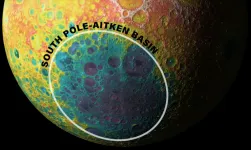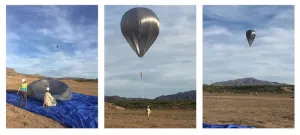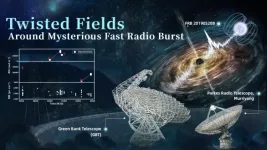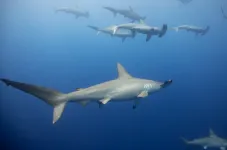(Press-News.org) SAN ANTONIO — May 11, 2023 —Southwest Research Institute has entered into a five-year, $7.5-million cooperative agreement with NASA to lead the Center for Lunar Origin and Evolution (CLOE), which will conduct basic research to support science enabled by human exploration of the Moon and the Endurance-A mission concept, a far side lunar rover mission prioritized by the 2022 Planetary Science and Astrobiology Decadal Survey report, “Origins, Worlds, and Life.” CLOE will be part of NASA’s Solar System Exploration Research Virtual Institute (SSERVI).
“The Moon is unmatched in its potential to provide fundamental advances in our understanding of the origin and early evolution of the Solar System,” said SwRI’s Dr. William Bottke, CLOE principal investigator. “Human exploration of the Moon revolutionized lunar science in the past and promises to do so again in the near future.”
Apollo samples from the lunar nearside provided the foundation for current knowledge of the Moon’s composition, crust and bombardment up to 4 billion years ago. But the earliest history of the Moon in its first 500 million years remains less well understood. NASA’s Artemis Program will send humans back to the Moon starting in the mid-2020s with landings in the south polar region. Exploration of the more ancient lunar far side will reveal the preserved record of the earliest bombardment of the Moon, including the oldest and largest impact basin, the 1,500-mile-wide South Pole-Aiken (SPA) basin, which extends from near the south pole to cover much of the far side’s southern hemisphere.
The far side of the Moon is the hemisphere that always faces away from Earth because of the Moon’s synchronous rotation. Compared to the near side, the far side terrain is rugged, with a multitude of impact craters and relatively few of the large, dark basaltic features characteristic of the nearside.
“Exploring the Moon has tremendous potential for supporting transformative science,” said CLOE Deputy Principal Investigator Dr. Robin Canup, vice president of SwRI’s Solar System Science and Exploration Division. “Models indicate that the Moon formed via a titanic collision with the Earth at the end of our planet’s formation. Clues needed to unravel the nature of this event are still on the Moon and can help us better characterize terrestrial planet formation.”
CLOE will focus on models of terrestrial planet formation and early lunar bombardment, the conditions of Earth-Moon origin, and how exploration of the SPA basin can allow us to better understand solar system formation and early evolution. Because the impact that formed SPA was so large, it almost certainly excavated material from the Moon’s deep interior. Collecting samples of these materials would significantly expand knowledge of the Moon’s bulk composition and subsurface volatile content — key data needed to reveal the conditions of the Earth-Moon origin and the thermochemical evolution of a young rocky world.
“The time is ideal for SSERVI — a program designed to work at the interface of NASA’s robotic scientific and human exploration programs — to play a central role in supporting and maximizing the scientific return from planned lunar exploration,” said Bottke. “The envisioned Endurance-A robotic rover would traverse SPA and collect carefully selected samples to be delivered to Artemis astronauts for return to Earth, producing an Apollo-class sample set from the far side of the Moon.”
CLOE includes 18 investigators from eight U.S. institutions — SwRI, the University of Colorado, the University of Arizona, the Jet Propulsion Laboratory, the Space Studies Institute, the Lunar and Planetary Institute, Purdue University and Yale — as well as many collaborations with international scientists. SSERVI is a virtual institute headquartered at NASA’s Ames Research Center, with members distributed among universities and research institutes across the United States and around the world. SSERVI is working to address fundamental science questions and issues that can help further human exploration of the Solar System.
For more information, visit https://www.swri.org/planetary-science.
END
SwRI to lead NASA/SSERVI Center for Lunar Origin and Evolution
Center will support science enabled by human, rover exploration of the far side of the Moon
2023-05-11
ELSE PRESS RELEASES FROM THIS DATE:
Google Quantum AI braids non-Abelian anyons for the first time
2023-05-11
Our intuition tells us that it should be impossible to see whether two identical objects have been swapped back and forth, and for all particles observed to date, that has been the case. Until now.
Non-Abelian anyons - the only particles that have been predicted to break this rule - have been sought for their fascinating features and their potential to revolutionize quantum computing by making the operations more robust to noise. Microsoft and others have chosen this approach for their quantum computing effort. But after decades of efforts by researchers in the field, observing non-Abelian anyons and their strange behavior has proven challenging, ...
Solar-powered balloons detect mysterious sounds in the stratosphere #ASA184
2023-05-11
CHICAGO, May 11, 2023 – Imagine if sending your science experiment 70,000 ft in the air just took painter’s plastic, tape, a dash of charcoal dust, and plenty of sunlight.
Daniel Bowman of Sandia National Laboratories will present his findings using solar-powered hot air balloons to eavesdrop on stratospheric sounds at the upcoming 184th Meeting of the Acoustical Society of America, running May 8-12 at the Chicago Marriott Downtown Magnificent Mile Hotel. His presentation will take place Thursday, May 11, at 2:50 p.m. Eastern U.S. in the Purdue/Wisconsin ...
Earth system modeling and fossil data reveal Homo adaptation to diverse environments
2023-05-11
Homo species – particularly Homo sapiens – were uniquely equipped to adapt to highly diverse environmental conditions and landscape mosaics, according to a new study, which may have enabled our species and that of our closely related ancestors to survive and thrive in highly fluctuating Pleistocene environments. Homo sapiens are the only surviving hominin species today. However, whether this is because our species was uniquely successful at adapting to Pleistocene environments, because we outcompeted other contemporary Homo species through unique physiological or social adaptations, ...
A better route to benzocyclobutenes, sought-after buildingblocks for drugs
2023-05-11
LA JOLLA, CA— Scripps Research chemists have solved a long-standing problem in the field of pharmaceutical chemistry with a relatively simple and controllable method for making benzocyclobutenes (BCBs)—a class of reactive compounds that are highly valued as building blocks for drug molecules, but have been relatively hard to access.
The new method, described in a paper in Science on May 12, uses designer ligand molecules with palladium-atom catalysts to break pairs of adjacent methylene-type C-H bonds in relatively cheap and abundant carboxylic acids. Breaking these bonds enables the making ...
Researchers discover twisted fields around mysterious fast radio burst
2023-05-11
Fast Radio Bursts (FRBs) are the brightest millisecond-duration cosmic explosions in radio bands. Their unknown origin poses challenges for astronomy as well as physics.
The Commensal Radio Astronomy FAST Survey (CRAFTS), a key program of the Five-hundred-meter Spherical radio Telescope (FAST), discovered the world's first persistently active repeating FRB, known as FRB 20190520B. Now this FRB has provided clues that may help clarify the origin of FRBs.
An international team led by Dr. LI Di from the National Astronomical Observatories of the Chinese Academy of Sciences (NAOC) carried out a monitoring campaign of FRB 20190520B, using the Parkes telescope in Australia and ...
U.S. Fishing Policy is Boosting Fish Populations, Not Constraining Most Fisheries
2023-05-11
Commercial fishing employs 1.2 million Americans and generates more than $165 billion annually. Yet warming waters are threatening fish populations and disrupting fisheries around the world—a challenge set to worsen as climate change advances. Despite the importance of sustaining fisheries, the reauthorization of the cornerstone policy protecting them in the United States—the Magnuson-Stevens Act—has been stalled in Congress for a decade. The holdup? Some blame the policy for being too stringent and leading to what they call “underfishing,” while others ...
Human ancestors preferred mosaic landscapes and high ecosystem diversity
2023-05-11
A new study published in the journal Science by an international team finds that early human species adapted to mosaic landscapes and diverse food resources, which would have increased our ancestor’s resilience to past shifts in climate.
Our genus Homo evolved over the past 3 million years – a period of increasing warm/cold climate fluctuations. How early human species have adapted to the intensification of climate extremes, ice ages, and large-scale shifts in landscapes and vegetation remains elusive. ...
Hammerhead sharks hold their breath on deep water hunts to stay warm
2023-05-11
Scalloped hammerhead sharks hold their breath to keep their bodies warm during deep dives into cold water where they hunt prey such as deep sea squids. This discovery, published today in Science by University of Hawai‘i at Mānoa researchers, provides important new insights into the physiology and ecology of a species that serves as an important link between the deep and shallow water habitats.
“This was a complete surprise!” said Mark Royer, lead author and researcher with the Shark Research Group at the Hawai‘i Institute of Marine Biology (HIMB) in the UH Mānoa School of ...
The feeling of hunger itself may slow aging in flies
2023-05-11
From low-carb to intermittent fasting, surgery to Ozempic—people turn to a seemingly never-ending array of diets, procedures and drugs to lose weight. While it has been long understood that limiting the amount of food eaten can promote healthy aging in a wide range of animals, including humans, a new study from University of Michigan has revealed that the feeling of hunger itself may be enough to slow aging.
Previous research has demonstrated that even the taste and smell of food can reverse the beneficial, life-extending effects of diet restriction, even without its consumption.
These intriguing findings drove first author Kristy Weaver, Ph.D., principal investigator ...
Nature is changing as land abandonment increases
2023-05-11
When people leave their rural lives behind to seek their fortunes in the city or agriculture is no longer profitable, the lands they toiled on are often left unused. A new perspective piece in Science shows that these abandoned lands could be both an opportunity and a threat for biodiversity, and highlights why abandoned lands are critical in the assessment of global restoration and conservation targets.
The past 50 years have seen an increased exodus of populations from rural to urban areas. Today, 55% ...
LAST 30 PRESS RELEASES:
For teens, any cannabis use may have impact on emotional health, academic performance
School meals could unlock major gains for human and planetary health
Menopause hormone therapy does not appear to impact dementia risk
Signature patterns of brain activity may help predict recovery from traumatic brain injury
Dresden study uncovers new key mechanism in cancer cells
New species are now being discovered faster than ever before, study suggests
Cannabis-based products show limited short-term benefit for chronic pain, with increased risk of adverse effects
Cannabis products with more THC slightly reduce pain but cause more side effects
Clearing the brain of aging cells could aid epilepsy and reduce seizures
Brain injuries linked with potential risk of suicide, new study finds
New technique lights up where drugs go in the body, cell by cell
New study finds movement of fishing fleets can reveal shifts in marine ecosystems
Embargoed: New evidence points to potential treatment for vascular dementia
Study uncovers disrupted brain balance in alcohol dependence
Working in groups can help Republicans and Democrats agree on controversial content moderation online
Structural findings reveal how distinct GPCR ligands create different levels of activation
Anything-goes “anyons” may be at the root of surprising quantum experiments
UC review: Maximizing workplace opportunity for veterans
From generation to complex control: Metasurfaces make perfect vortex beams "within reach"
Thin-film lithium niobate-based detector: recent advances and perspectives
Exploring why some people may tend to persistently make bad choices
How cells balance their protein levels
Nirsevimab vs RSVpreF vaccine for RSV–related hospitalization in newborns
Effectiveness and impact of maternal RSV immunization and nirsevimab on medically attended RSV in US children
AI gives scientists a boost, but at the cost of too many mediocre papers
Next-generation vision model maps tree growth at sub-meter precision
Genes aren’t destiny for inherited blindness, study shows
MIT study: High-fat diets make liver cells more likely to become cancerous
Exposure to multiple fine particulate matter components and incident depression in the US Medicare population
Risk of burdensome health care spending over time in the US
[Press-News.org] SwRI to lead NASA/SSERVI Center for Lunar Origin and EvolutionCenter will support science enabled by human, rover exploration of the far side of the Moon






